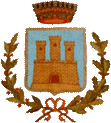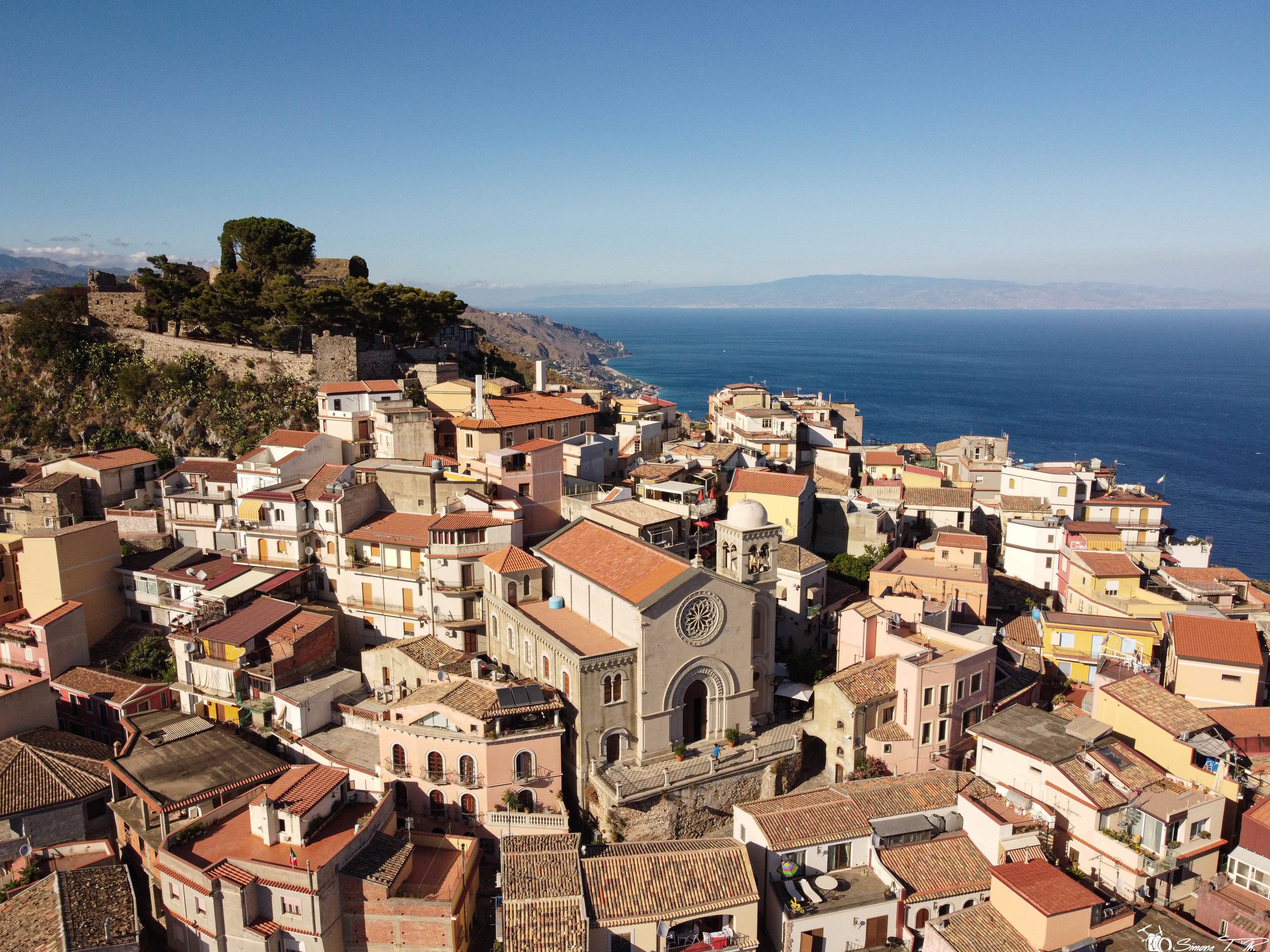

É un piccolo paese che sorge su un'altura a strapiombo sul mar Jonio. Il nome deriva dalla conformazione della sua posizione posta su un masso che ricorda una "mola".
Originariamente era denominata Mylai.
Le sue origini risalgono all'età del ferro (circa VIII sec. a.C.) quando forse costituiva l'acropoli di Taormina. Furono, però, i Siculi che nel 396 a.C. cominciarono a costruirne i bastioni per difendersi dagli attacchi di Dionisio, tiranno di Siracusa, che alla fine la conquistò. Da qui fu sottoposta al dominio dei diversi governatori che si succedettero e dopo la caduta dell’impero romano d'Occidente passò al dominio bizantino e quindi a quello arabo, e nel 1078 a Ruggero II Normanno che costruì il centro abitato intorno al castello denominato "Mola" nelle vicinanze del quale fece costruire la chiesa che, per ringraziamento della vittoria sui saraceni, dedicò alla Madonna SS. Annunziata Dopo i Normanni, vi furono gli Svevi, poi gli Angioini e gli Aragonesi il cui regno si dimostrò molto infelice per Mola in quanto gli spagnoli sottoponevano la popolazione ad ingenti tasse e altre difficoltà sino al 1738 quando Mola fu inclusa nel Regno delle Due Sicilie e, infine, nel 1860 fu annessa al Regno d'Italia. Le antiche e nobili famiglie che si succedettero in epoca feudale furono prima i Marullo, poi i Castello ed infine i Villadicane. Nel 1928 venne annessa al comune di Taormina e fu solo nel 1947 che acquistò indipendenza amministrativa.
Purtroppo, nel 1928 alcune peculiarità urbanistiche furono modificate, anche se conserva ancora l'antico arco d'ingresso al castello che domina Piazza S. Antonino, alla sommità di una splendida gradinata in pietra calcarea. Dalla piazza rivestita in pietra lavica è possibile ammirare un bellissimo panorama sulla sottostante Taormina.
Il borgo conserva ancora alcune caratteristiche medievali con il suo intersecarsi di viuzze con insegne in pietra e ferro battuto.
Uno dei percorsi turistici ha inizio dalla C.da Annunziata al Monte Venere e alle “ Scalazze” che furono costruite per portare i nobili in campagna attraverso la “Grotta dei Monaci”.
Da visitare: il Castello di Mola di cui rimangono i ruderi delle antiche mura normanne; la Chiesa madre dedicata a S. Nicola (1934-1935) sulla preesistente cattedrale del 1500 e presenta una mescolanza di stili tra il romanico, il gotico, l'arabo e il normanno con elementi originari come il portale laterale, l'arcata del coro e gli altari; la Chiesa di S. Giorgio costruita intorno al 1450 dallo stile molto lineare ma di cui eccelle l'antico campanile, all'interno di pregio un imponente organo, nella pavimentazione sono delle lapidi sepolcrali delle due congregazione di S. Giorgio dalla quale si accede alla sottostante cripta con delle catacombe e del SS. Crocifisso, inoltre ospita delle notevoli opere d'arte: vi è poi la Chiesa di S. Biagio la prima costruita nel paese a ridosso di una roccia; ed infine la già citata Chiesa dell'Annunziata con un portale molto pregiato.
Tra i prodotti tipici il vino alla mandorla, detto "Blandanino" dal nome del suo creatore, da gustare presso lo storico Caffè S. Giorgio fondato nel 1700 e situato nella piazza principale, il visitatore potrà anche dare un'occhiata all'insolito Bar Turrisi.
Interessanti le cisterne per l'acqua del 367 a.C. e l'Antica Porta dei Saraceni sul percorso pedonale detto "Via dei Saraceni" o "Piano delle Ficarre"(così denominato per le piante di fichi d'india che lo costeggiano).
(English)
It is a small town that rises on a hill overlooking the sea. The name derives from the conformation of its position placed on a rock that resembles a “mola” (millstone) ".
It was originally called Mylay
Its origins date back to the Iron Age (about VIII century. BC) when perhaps it constituted the Acropolis of Taormina. It was, however, the Siculi who in 396 BC began to build the bastions to defend themselves from the attacks of Dionysius, tyrant of Syracuse, who ultimately conquered it. From here it was subjected to the dominion of the various governors who succeeded each other and after the fall of the Western Roman Empire it passed to the Byzantine, therefore to Arab domination, and in 1078 to Roger II Norman who built the town around the castle called "Mola" in the vicinity of which he built the church that, to thank the victory over the Saracens, is dedicated to Our Lady SS. Annunziata. After the Normans, there were the Swabians, then the Angevins and the Aragoneses whose Kingdom proved very unfortunate for Mola, because the Spanishes subjected the population to large taxes and other difficulties until 1738 when Mola was included in the Kingdom of the Two Sicilies and finally in 1860 was annexed to the Kingdom of Italy. The ancient and noble families that succeeded each other in feudal times were first the Marullo, then the Castello and finally the Villadicane. In 1928 it was annexed to the municipality of Taormina and it was only in 1947 that it acquired administrative independence.
Unfortunately, in 1928 some urban peculiarities were modified, although it still preserves the ancient entrance arch to the castle overlooking Piazza S. Antonino, at the top a splendid limestone staircase.
From the Square covered in lava stone you can admire a beautiful view of belowed Taormina.
The village still retains some medieval features with its intersecting of streets and with signages in stone and wrought iron.
One of the tourist routes starts from C. Da Annunziata to Monte Venere and to the "Scalazze“ that were built to take the nobles to the countryside through the”Grotta dei Monaci".
To be visited: the castle of Mola of which remain the ruins of the ancient Norman walls; the Mother Church dedicated to St. Nicola (1934-1935) on the pre-existing Cathedral of the 1500 and that presents a mixture of styles between Romanesque, Gothic, Arabic and Norman with original elements such as the side portal, the Arch of the choir and the altars; the Church of St. Giorgio built around 1450 in a very linear style but of which it excels the ancient bell tower; inside there is a prestigious organ, and in the pavement there are the tombstones of the two confraternities: the one of St. Giorgio, by which can enter the crypt below and with some catacombs, and the other of SS. Crucifix, that also houses remarkable works of art: there is then the Church of S. Biagio the first one built in the country close to a rock; and finally the aforementioned Church of the Annunziata with a very valuable portal.
Among the typical products the almond wine, called "Blandanino" from the name of its creator, to taste at the historic coffee S. Giorgio founded in 1700 and located in the main square, the visitor can also take a glance at the unusual “Bar Turrisi”.
Interesting are the water cisterns of 367 BC and the ancient gate of the Saracens on the pedestrian path called "Via dei Saraceni" or "Piano delle Ficarre" (so named for the prickly pear plants that line it).